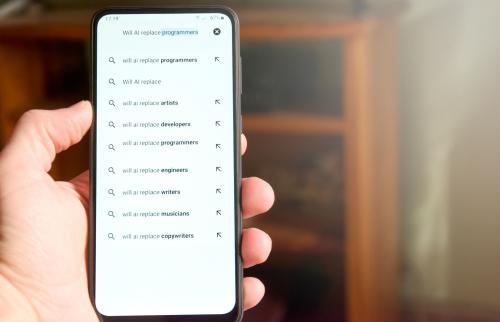This week’s stunning announcement by AT&T that it had reached an agreement to acquire BellSouth for $67 billion is surely an affront to proponents of a strong antitrust policy for two reasons. First, it looks like a big step toward putting Ma Bell back together 22 years after the trustbusters’ biggest victory since the breakup of Standard Oil in 1911. Second, they know that the antitrust authorities will find it very difficult to derail this merger because it poses no threat whatsoever to the vitality of competition in the communications sector.
The AT&T/BellSouth merger is simply the latest indication of the irrelevance of antitrust in a rapidly changing global competitive environment. In telecommunications, the changes in competition have come from an explosion in technology and at least partial freedom from the suffocating embrace of government regulation. In other sectors, the growth in the global economy and world trade has made it increasingly difficult to find examples of firms with sustainable market power. What firm in the motor vehicles, chemicals, banking, primary metals or energy business could be said to have the power to affect price by restricting its own output? Moreover, we can now think the unthinkable: Would consumer welfare seriously be threatened if Ford and General Motors merged? What about a merger of U.S. Steel and Mittal Steel? As long as international borders are open, competition flourishes even without an antitrust authority.
The dearth of demonstrable benefits from antitrust policy in recent years underscores the problem. Consider the Justice Department’s monopolization case against Microsoft, which ended with a remedy that left both sides wondering, “What was the point?” The case continues in Europe where trustbusters are pressuring Microsoft to unbundle its Media Player software from its PC operating system. Meanwhile, Steve Jobs’s bank account grows while his iPod technology shows how impotent Microsoft is in the music/video business. It is our experience that when a U.S. proponent of antitrust is pressed to suggest an example of the policy’s success, he will not point to Microsoft, but to — you guessed it — the breakup of AT&T.
The AT&T case is an important political prop in the current support for antitrust because, as we have shown in a 2003 Journal of Economic Perspectives article, there is a paucity of empirical evidence that more than a century of antitrust enforcement has provided benefits to U.S. consumers. Yes, there are the “what about . . .” responses, such as the successful attack on the electrical equipment price-fixing conspiracy in the 1960s, the prosecution of a 1990s international vitamins cartel and even some uninformed comments on the “success” of breaking up Standard Oil after John D. Rockefeller had retired and new discoveries of oil had greatly reduced the market power of the company he had founded. But no one has yet pointed to a serious academic study that shows that antitrust has led to lower prices, greater output or increased technological progress.
To the contrary, one of the few systematic investigations into the effects of price-fixing conspiracies showed that prices generally rose after a successful government prosecution of a conspiracy under Section 1 of the Sherman Act. Nor is there evidence that the government’s assault on monopolization under Section 2 of the Sherman Act has been successful. We have found no evidence that successful prosecutions of Standard Oil (1911), American Tobacco (1911), Alcoa (1945), the movie companies (1948) and United Shoe Machinery (1954) have led to lower prices or greater output in the industries in which they operated.
Finally, the antitrust authorities have had a poor recent track record in the federal courts when merger participants challenge their attempt to block a merger under the Clayton Act. The DOJ still feels the sting of a 2004 federal court denial of its attempt to block the Oracle/People Soft merger. It is highly doubtful that justice would improve its record with a legal assault on the AT&T/BellSouth merger.
AT&T and BellSouth offer conventional telephone service in different regions of the country. AT&T (formerly called “Southwestern Bell”) operates in the Southwest, Far West and the Midwest. BellSouth provides telephone service in the Southeast. Both companies are losing subscriber lines rather rapidly as consumers switch to cellular phones or “voice over Internet protocol” (VOIP) provided by the cable companies or independent providers, such as Vonage. The new broadband (DSL) Internet services offered by these erstwhile phone titans have not been sufficient to offset the revenue losses from traditional telephone services. All old-line telephone companies are now desperately trying to enter the video market in their own regions so that they can begin to show modest growth once again. Combining these two companies may provide some useful synergies in their battle to compete with the cable television companies, but one would have to employ a fanciful argument to conclude that the merger gives them measurable power to raise the price of phone service, DSL or video services.
AT&T and BellSouth jointly own Cingular, the largest of the four national cellular carriers. Although the merger may solidify AT&T’s control over Cingular because it raises its interest in ownership from 60% to 100%, it surely does not provide AT&T with any power to raise cellphone rates. Verizon Wireless, Sprint and T-Mobile will continue to compete with Cingular, as before.
Like many episodes in antitrust, the matter at hand has emerged while industry competition is undergoing significant and unpredictable changes. Cable companies are invading the old-line telephone companies’ core telephone business while retaining more than half of the new broadband Internet business. Cellular carriers are beginning to offer high-speed Internet connections and are even launching video services over cellphones. Satellites with directed “spot beams” will soon be able to offer high-speed Internet service. Google has announced its intention to deploy a fixed wireless WiFi service throughout San Francisco. Might Yahoo, Microsoft or Apple begin to consider similar moves? Most of us now make our long-distance calls at zero prices on evenings or weekends over our cellphones, or we simply rely on email and Instant Messenger.
In the midst of such upheavals, government antitrust “victories” have proven to be illusory precisely because the trustbusters could not anticipate how the markets involved were changing. It will be extremely difficult for anyone to argue with much credibility before a federal judge how the AT&T/Bell South merger will affect the prices and output of telecom or video services for the foreseeable future.
Antitrust proponents might then be reduced to arguing that the merger is clearly a backward step in the face of benefits to consumers from breaking up AT&T in 1984. However, telephone rates are no lower in the United States than in most other developed countries, which wisely decided that they should not break up their national telephone companies and suffer through two decades of legal and regulatory hell that offers little improvement in competition. Appearing to put Ma Bell back together again may embarrass the trustbusters, but it should not concern American consumers who, in two decades since the breakup, are overwhelmed with competitive options to provide whatever communications services they desire.
The Brookings Institution is committed to quality, independence, and impact.
We are supported by a diverse array of funders. In line with our values and policies, each Brookings publication represents the sole views of its author(s).



Commentary
Op-edThe AT&T/BellSouth Merger: The Breakdown of ‘Breakup’
March 9, 2006